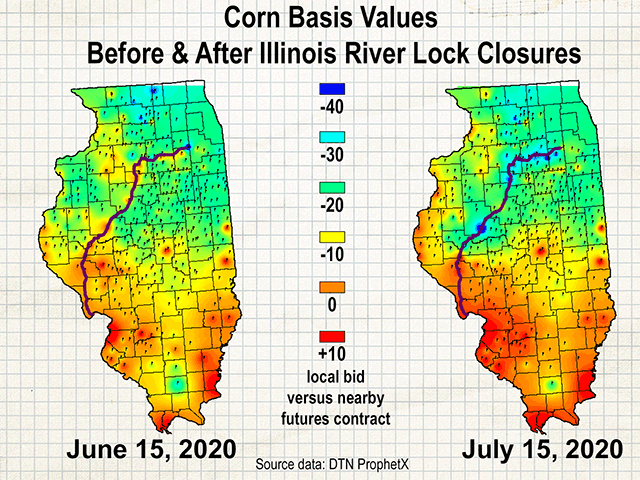Kub's Den
Lock Closures: The Basis Apocalypse That Wasn't
All basis, like all politics, is local. A spring wheat farmer in Montana probably doesn't care that corn basis at the Gulf of Mexico is 57 cents over the nearby futures contract. And a cotton farmer in Oklahoma probably doesn't care that Pennsylvania dairies are paying 15 cents under for their corn. Here, where I am in the Western Corn Belt, we tend to only have a vague interest in barge freight rates and CIF corn prices on the Eastern Corn Belt's waterways. Nevertheless, some much-anticipated repair work along the Illinois River's lock and dam facilities, which began on July 1 and are scheduled to continue through the end of October, gave the corn market an opportunity to demonstrate its resilience, with transportation lessons that will be valid for industry participants everywhere.
Typically, 22% of all barged grain headed toward the Gulf of Mexico spends some time floating down the Illinois River. So, the thought of suddenly losing this major shipment route for soybeans, corn and wheat (not to mention the other commodities that rely on both upbound and downbound barge movement), understandably filled the region with dread. Processing facilities that receive grain directly off the water would have to scramble to get their supplies. Grain shipping firms would struggle to trade their usual volumes or hedge unknown alternate transportation costs. And farmers, of course, at the start of the supply chain, feared higher transportation costs and a potential loss of competitors bidding for grain would lead to weaker local grain prices.
Fortunately, the specific intention of this July-October 2020 shutdown was to prevent some sudden failure of the concrete or the mechanical or electrical systems sometime in the future. A well-publicized, long-planned-for rehabilitation now should (fingers crossed) prevent a sudden, catastrophic failure down the road.
P[L1] D[0x0] M[300x250] OOP[F] ADUNIT[] T[]
Amazingly, the grain shipping industry -- rich with alternative networks of other shipping options (trucks, trains, barges on other rivers) and with traders who capitalize on the opportunities in front of them (shipping extra grain before July 1, or storing extra grain until October) -- has proven its resilience.
As the USDA's Kelly Nelson wrote in their July 2 Grain Transportation report, "The timing of the closures will likely minimize the cost increases associated with trucking longer distances [e.g. to Mississippi River barge loading facilities]. Compared to other times of year, the third quarter (when the river will be closed) tends to have the lowest trucking rates for the north-central United States, especially on long-haul routes."
These days, once the southbound grain finds its way to the Mississippi River instead of the Illinois River, it seems to be encountering a new surplus of towboats and barges that have been redeployed there, helping to tamp down some of the dreaded transportation cost increases. Above-average grain movement by barge during April, May and June cleared the way for a slower pace and relative slack in the system now. The total of barge shipments of grain reached 1,091,741 tons during the week of June 20, 2020, -- a volume not usually seen except at harvest time, and 252% of the volume shipped during the same week last year. During the week of July 19, total grain shipments have gone back to resembling their three-year average pace, at 746,792 tons -- even without the Illinois River's locks and dams in service.
The result, therefore, has been very little calamity for local grain basis in Illinois. Barge loaders directly on the Illinois River, of course, have dropped their bids. Where there was once a price tag of 10 cents over the futures contract during the final push to get grain shipped in the second half of June, now the bid may be 40 cents under. But for the elevators elsewhere in the state, especially in the southern half where basis bids have heated up across the board, the closure of the locks and dams has not had a dramatic effect. For instance, at a large commercial grain terminal along the river at Havana, Illinois, the corn basis bid moved from +3N ($3.32 cash versus $3.29 futures) in the middle of June to now -30U ($2.96 cash versus $3.26 futures) in the middle of July. Meanwhile, the market has been more stable at a randomly selected representative grain and supply elevator in Livingston County, Illinois, where the corn bid went from -24N ($3.05 cash versus $3.29 futures) in mid-June to -19U ($3.07 cash versus $3.26 futures) in mid-July.
The lessons -- not only for Illinois grain owners, but for grain owners everywhere -- seem to be two-fold. First: planning ahead is good. The advance planning and orderly function of moving towboats and barges to an alternative river, having extra storage in place and moving extra volume while still possible is what prevented a basis calamity in this scenario. If, instead, an aging lock or dam were to fail and need to be closed unannounced for a great length of time, it's unlikely that the market wouldn't feel some lasting pain. Second: alternatives and redundancy are good. Even the Montana wheat farmer, the Oklahoma cotton farmer and the Pennsylvania dairy feed buyer should look at this scenario and be asking themselves, "What would my backup plan be if my major transportation route needed to shut down for four whole months?"
Elaine Kub is the author of "Mastering the Grain Markets: How Profits Are Really Made" and can be reached at masteringthegrainmarkets@gmail.com or on Twitter @elainekub
(c) Copyright 2020 DTN, LLC. All rights reserved.



